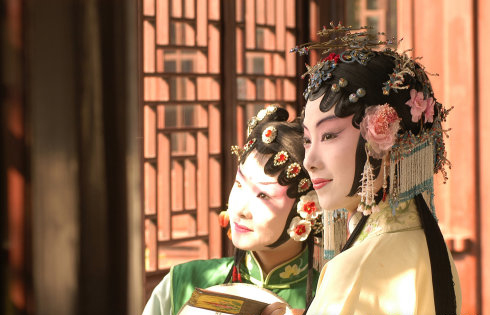
. > WHAT'S NEW > RESEARCH
Preservation of Chinese opera, modern drama
Author : SU PEI Source : Chinese Social Sciences Today 2017-07-12

The Peony Pavilion, a modern adaptation of the Ming playwright Tang Xianzu’s Kun opera masterpiece, brings the old art form back to the public eye.
The vitality of art lies in its preservation and development. Chinese theater, comprising both traditional operas and modern plays, shoulders the responsibility of cultural preservation and promotion. The urgent task facing researchers is to examine the current conditions of Chinese theater and derive more value from it.
Aesthetic spirit
Chinese traditional operas, such as Peking Opera, Cantonese opera and Kun opera, are among the world’s oldest opera cultures. These unique Chinese creations contain profound artistic value and rich humanistic connotations. Lü Xiaoping, dean of the Institute of Theater and Film Art at Nanjing University, said representative figures of traditional Chinese operas are great literati, such as Guan Hanqing and Tang Xianzu. In modern times, representative figures include performing artists Tan Xinpei and Mei Lanfang. From ancient to modern times, despite periodic breakdowns in overall artistic development, there are numerous texts that remain today.
Drama has flourished since its introduction to China. Song Baozhen, vice-president of the Institute of Drama Studies at the Chinese National Academy of Arts, said that as an emerging artistic form in China, drama is more inclusive and comprehensive. It provides an open and diverse artistic space. Although drama did not exist for a long time in China, it is vibrant enough to contain various new ideas and techniques of expression.
Operas and drama share much in common in staging a story, shaping characters and expressing emotions, while they differ a lot in aesthetic manners and performance styles. Finding and interpreting the aesthetic spirit of the various forms of theater is an important task. Zhou Quan, a professor of dramatic literature from the Central Academy of Drama, said the aesthetic spirit of theater involves reflecting upon the development path of the human spirit and ideology or, in other words, the objectification of humans. Drama is an art of practice and its aesthetic theories have not received enough attention, and have thus lagged far behind practice. Many practitioners reject theories, while theorists do not properly acknowledge the facts. Zhou suggests staying up to date with the latest developments in the field.
For a long time, Chinese theatrical scholars conducted a lot of research into traditional aesthetic texts, while ignoring research on theatricality. Zhou argued that the first step of innovative development is to restore the historical context. This involves emphasizing the unchanging part to ensure the generality of theatrical art, and, more importantly, emphasizing the dynamic part, or, the heterogeneity of drama, to know its laws of development.
Creations
Today, Chinese drama has established its own traditions, aiding its future development. Song said he hopes that China can produce great works of extensive influence, profound impact, and long-lasting aesthetic significance.
Song added that Chinese drama has a large number of creations but faces many hidden challenges. The major problem is that few works have the potential to be “classics,” or the kind of works with ideological foresight and insight. Also, theoretical interpretations are also flawed: first, there is only fuzzy recognition of theories and concepts; second, a lack of an integral ideological systems; third, few research teams; fourth, a thinking mode weighting more on feelings, lacking critical thinking.
Lü pointed out that a leap forward in the century-long development of Chinese theater is the formation of modern stylistic features. The first style of Chinese opera was zaju of the Yuan Dynasty; the second, chuanqi of the Ming and Qing dynasties; the third, local operas, and the fourth is modern theater.
One major feature of modern theater dramas is that they have revived literary traditions of opera that were not classic literary traditions in Guan and Tang’s age, but which are now features of new literature in modern times. Since the founding of the People’s Republic of China, modern opera literature has gradually matured. Opera’s embrace of literature has nurtured a series of high-quality opera works.
The attitude toward traditions is an important issue in Chinese opera development. Lü argued that traditions are not burdens. Artists and playwrights should regard traditions as sources, based on which new creations spring up. “We should support artistic talent and troupes and embrace the market. We should not isolate ourselves from the audience, but create works worth the price of admission. In addition, we have to admit the differences between modernity and traditions, creating opera texts for our own age,” Lü added.
Ye Shengtao made Chinese fairy tales from a wilderness
Ye Shengtao (1894–1988) created the first collection of fairy tales in the history of Chinese children’s literature...
-
How northern ethnicities integrated into Chinese nation
2023-09-18
-
Mogao caves
2023-09-12
-
Mogao Grottoes as ‘a place of pilgrimage’
2023-09-12
-
Time-honored architectural traditions in China
2023-08-29
-
Disentangling the civilizational evolution of China
2023-08-28
-
AI ethics in science fiction
2023-08-23













 2011-2013 by www.cssn.cn. All Rights Reserved
2011-2013 by www.cssn.cn. All Rights Reserved